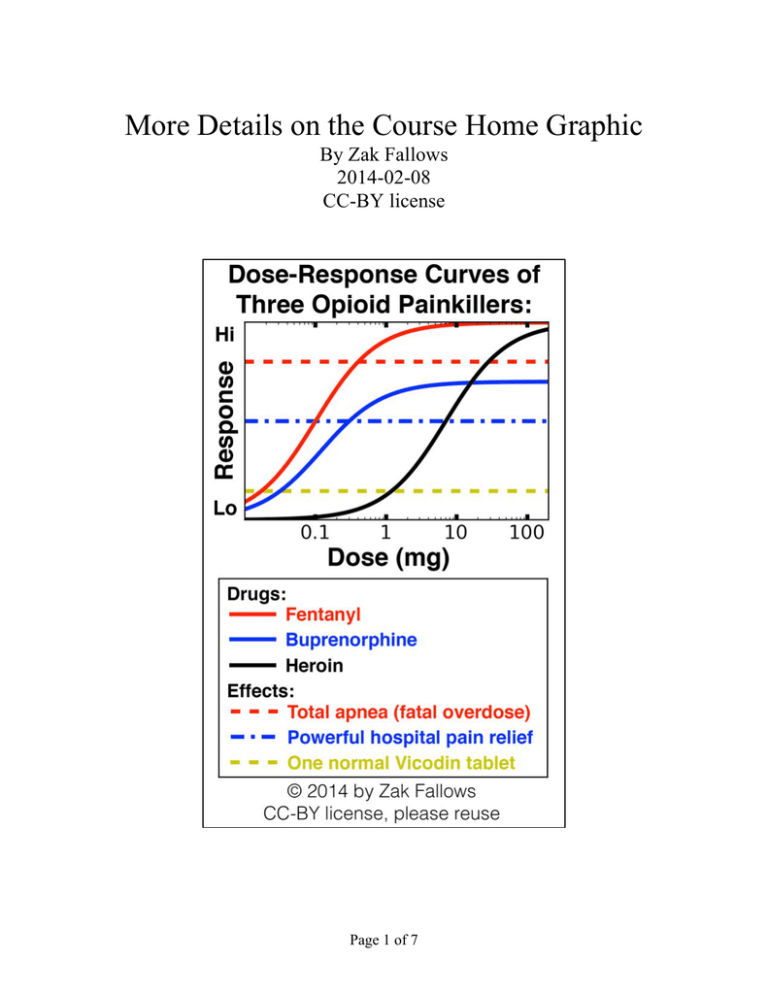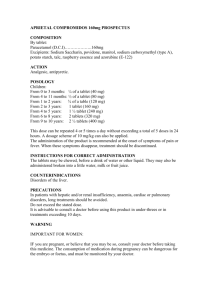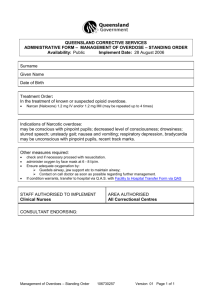Document 13564251
advertisement

More Details on the Course Home Graphic By Zak Fallows 2014-02-08 CC-BY license Page 1 of Page 2 of The images on the prior pages were created using the Python programming language and the Matplotlib graphing library. All the necessary source code is in the following file: drc.py The file drc.py can be found in the “Study Materials” section on OCW. The letters DRC in the filename stand for “dose-response curve”. The file contains instructions for how to use it, in case you are not familiar with the tools. Buprenorphine Overdose: Buprenorphine alone will generally never cause a fatal overdose. This can be seen because the solid blue buprenorphine curve never gets high enough to cross the dashed-dotted red line for "total apnea (fatal overdose)". However, buprenorphine can cause a fatal overdose if it is mixed with other sedating drugs such as alcohol or benzodiazepines. Mixing buprenorphine with other opioids, such as heroin, may actually prevent heroin overdose because the buprenorphine will displace the heroin from opioid receptors. But if the dose of heroin is too high or the dose of buprenorphine is too low, death will occur. Using Opioids for Surgical-Depth Anesthesia: You may have noticed that the dashed blue line for "surgical depth anesthesia" is actually above the dashed-dotted red line for "total apnea (fatal overdose)". This means that a dose of opioid high enough to perform surgery will almost always cause total apnea, which means total cessation of breathing. This would normally cause death, but in the operating room it is possible to insert a tube down the patient's throat to periodically pump in oxygen and suck out carbon dioxide. This is called mechanically ventilating the patient. This can be done safely. Even extremely large doses of morphine and fentanyl do not cause toxicity to any organs, the only problem is the total cessation of breathing. However, opioid-only surgical anesthesia is not common because other drug regimens are even safer and have fewer side effects. How to Read a Dose-Response Curve: The two graphs below both represent the dose-response relationship of morphine, and they both have crosshairs drawn at the same 5 points. However, the top graph uses a linear scale for the xaxis (dose) and the bottom graph uses a logarithmic scale for the x-axis. The x-axis represents the dose, in milligrams, of morphine. This dose is given intravenously (IV). If morphine is given orally, then it is one third to one sixth as potent. Page 3 of The units of the y-axis (response) are not specified, and that is purposeful. Any proxy measure for drug efficacy can be plotted on the y-axis of a dose-response curve. Since morphine is a painkiller, we could make the y-axis pain relief, as rated on a scale from one to ten. If we did that, we would have to trim off the top portion of both graphs because the patient loses consciousness somewhere between C (20 mg) and D (40 mg). Page 4 of Horizontal lines are lines of equal efficacy. These can be called isoeffective lines, although that term is not in widespread use. In the two graphs above, isoeffective line D represents total apnea, or total cessation of breathing. When you reach this line, you generally die of an opioid overdose. To find what dose of morphine will cause a fatal overdose, you must find where the morphine curve (solid black line) crosses isoeffective line D (dashed gray line). Once you find the intersection, draw a vertical line down to the x-axis and read off the dose. You will find that 40 mg of IV morphine will cause a fatal overdose according to this graph. In the real world, a larger or smaller dose might cause a fatal overdose. The 5 crosshairs on the graphs above represent the following: Letter: A Dose (mg): 1.7 Height (%): Effect: 14.5 Equivalent to one normal Vicodin tablet. A normal Vicodin tablet contains 5 mg of hydrocodone and 500 mg of acetaminophen. It provides mild to moderate pain relief. B 10 50 C 20 66.7 D 40 80 E 60 85.7 Powerful hospital pain relief. You might receive this dose of IV morphine after a car accident. Strong euphoria. If you have no experience using opioids, this dose of IV morphine will produce powerful euphoria, heavy drowsiness, nausea, itching, and a feeling of warmth and relaxation. Warning: Never use drugs for fun. Warning 2: There is a significant chance that 20 mg of IV morphine could cause a fatal overdose, so if you do choose to use drugs for fun, be sure to start with a much lower dose. Total apnea. Total cessation of breathing. This usually means a fatal overdose. Surgical-depth anesthesia. When the surgeon cuts into you with a scalpel, you will not move, although your heart rate may increase. Page 5 of More Details on Dose-Response Curves: See the Week 7 Handouts on OCW. ©2014 by Zak Fallows This document is my own original work, and I hereby release this document and all the included images under a CC-BY license. Please feel free to reuse this work in whole or in part, just remember to give me credit. Page 6 of MIT OpenCourseWare http://ocw.mit.edu ES.S10 Drugs and the Brain Spring 2013 For information about citing these materials or our Terms of Use, visit: http://ocw.mit.edu/terms. Page 7 of 7



